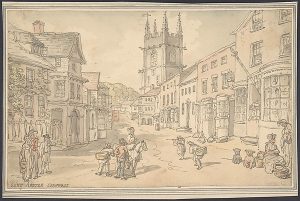“…There glimmering in the dawning beds, are seen
The more aspiring seeds of sprightly tin:
The copper sparkles next in ruddy streaks,
And in the gloom betrays its glowing cheeks”
-Sir Samuel Garth
|
|

|
| Overview | Bronze is an alloy of tin and copper. Cornwall and Devon, Great Britain were leading copper producers in the 18th century. After being mined, the copper and tin would be sent to Wales to be smelted. |
| Histories of Mining Tin and Copper in Cornwall | Cornwall and Devon began mining copper and tin in the 16th century and were producers of these metals into the 18th century. Cornwall was once known for it’s tin production and mined almost exclusively for it. By the 18th century, Cornish “adventurers” (today’s entrepreneurs) realized the value of copper and quickly became the world’s largest producer of copper. |
| Who worked in the mines? | It was not just men who worked in the mine, but women and children too. By eight or nine years old, a child would begin working for the mines above ground, and by 12 years old the child would begin working within the mine itself. Due to the hot temperatures, miners who worked below ground wore little clothing, heavy boots, and felt hats. Candles, one of the few sources of lights, were affixed to their hats. |
| Mining Conditions | Miners worked in cramped tunnels, where temperatures could reach over 100° Fahrenheit. Mineral dust, from the breaking of rocks, made it hard to see in the mines, and created poor breathing conditions. |
